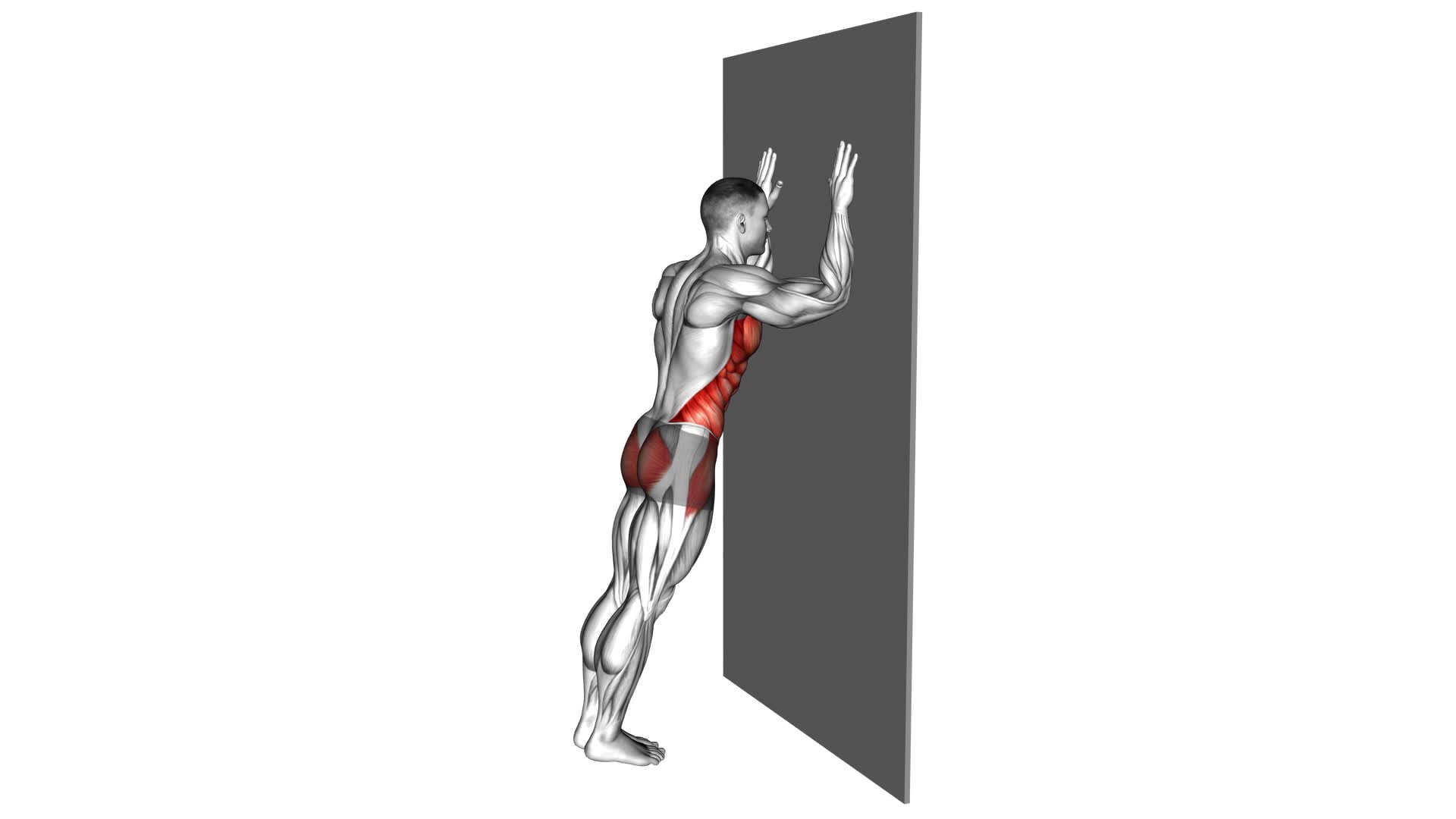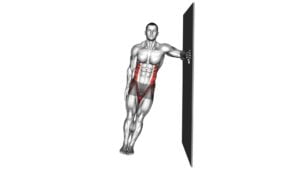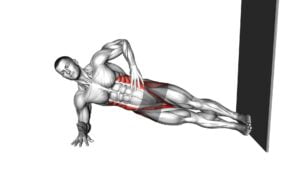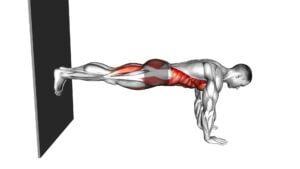Wall Plank (male) – Video Exercise Guide & Tips

Are you looking for an effective exercise to strengthen your core and upper body? Look no further than the wall plank!
Watch This Exercise Video
This video exercise guide and tips will show you the proper form and alignment, beginner modifications, breathing techniques, common mistakes to avoid, and advanced variations for a challenge.
With this comprehensive guide, you'll be able to take your fitness routine to the next level and achieve your goals.
Get ready to feel the burn and see results with the wall plank!
Key Takeaways
- Proper form and alignment are essential for a wall plank, including hands shoulder-width apart, feet hip-width apart, and maintaining a straight line from head to heels.
- Beginner modifications and progressions can help gradually increase the difficulty of a wall plank, such as starting with a wall plank on forearms and progressing to holding it for longer periods or adding shoulder taps or leg lifts.
- Breathing techniques, including inhaling deeply through the nose and exhaling fully through the mouth, can enhance results and improve the mind-body connection during a wall plank.
- Common mistakes to avoid during a wall plank include improper alignment, holding breath instead of breathing continuously, lack of progression, straining joints by not engaging core muscles, and not maintaining proper form for longer durations.
Proper Form and Alignment
To ensure proper form and alignment during the wall plank exercise, follow these guidelines:
- Position your body correctly by placing your hands shoulder-width apart and your feet hip-width apart.
- Engage your core by pulling your belly button towards your spine and squeezing your glutes.
- Maintain a straight line from your head to your heels, avoiding sagging or arching your back.
The wall plank offers several benefits, such as strengthening your core muscles, including your abs, obliques, and lower back. By engaging your core, you can improve your posture and spinal alignment, reducing the risk of rounded shoulders and a hunched back. Additionally, this exercise improves your balance and stability.
Now that you understand the importance of proper form and alignment, let's move on to discussing beginner modifications and progressions to help you gradually increase the intensity of your workout.
Beginner Modifications and Progressions
For beginners, there are several modifications and progressions you can incorporate into your wall plank exercise routine to gradually increase the intensity. It's important to start with proper alignment and form to avoid injury and get the most out of your workout.
Begin by standing facing the wall, about an arm's length away. Place your hands on the wall at shoulder height and walk your feet back until your body is in a straight line, similar to a push-up position. Make sure to engage your core muscles and keep your shoulders, hips, and heels in line.
If this is too challenging, you can start by performing the wall plank on your forearms instead of your hands. As you become more comfortable, you can progress by holding the wall plank for longer periods of time or by adding shoulder taps or leg lifts to increase the difficulty.
By gradually incorporating these modifications and progressions, you'll build strength and stability in your core and upper body.
Now, let's move on to the next section and learn about breathing techniques for enhanced results.
Breathing Techniques for Enhanced Results
Improve the effectiveness of your wall plank exercise by incorporating proper breathing techniques. Breathing exercises play a crucial role in enhancing your workout results and maintaining proper form. By practicing mindful breathing techniques, you can optimize your performance and engage your core muscles more effectively.
During the wall plank exercise, focus on inhaling deeply through your nose and exhaling fully through your mouth. As you inhale, imagine filling your lungs with air and expanding your diaphragm. This deep inhalation helps to oxygenate your muscles and provide them with the necessary energy to perform the exercise. As you exhale, engage your core muscles and push the air out, activating your abdominal muscles even further.
Mindful breathing techniques also help to keep you present and focused during the wall plank exercise. By paying attention to your breath, you can improve your mind-body connection and maintain proper alignment. This reduces the risk of injury and ensures that you're getting the most out of your workout.
By incorporating proper breathing techniques into your wall plank exercise, you can enhance your overall performance and achieve better results.
Now, let's move on to the next section and discuss some common mistakes to avoid for an effective wall plank workout.
Common Mistakes to Avoid
Avoiding common mistakes is crucial for maximizing the effectiveness of your wall plank exercise and achieving optimal results. To help you avoid these pitfalls and make the most out of your workout, here are some tips for improvement:
- Improper alignment: One common mistake isn't aligning your body correctly during the wall plank. Make sure your shoulders are directly over your wrists and your body forms a straight line from head to toe. This will engage your core muscles and prevent unnecessary strain on your joints.
- Holding your breath: Many people tend to hold their breath while performing the wall plank. Remember to breathe continuously and evenly throughout the exercise. This will oxygenate your muscles and help you maintain your form for longer periods of time.
- Lack of progression: Another mistake isn't challenging yourself enough. Once you have mastered the basic wall plank, try increasing the duration or adding variations such as leg lifts or side planks. This will ensure that you continue to progress and see improvements in your strength and stability.
Advanced Variations for a Challenge
To increase the difficulty of the wall plank exercise, try incorporating advanced variations that challenge your core muscles even further. These advanced modifications will push your limits and help you progress in your fitness journey.
One advanced variation is the wall plank with leg lift. Start in the wall plank position with your feet on the wall. Slowly lift one leg off the wall while maintaining a strong plank position. Hold for a few seconds, then lower the leg and repeat on the other side. This modification adds an extra challenge by engaging more muscles in your core and lower body.
Another option is the wall plank with knee tuck. Begin in the wall plank position and bring one knee towards your chest. Hold for a moment, then extend the leg back to the starting position. Repeat on the other side. This variation targets your abs and hip flexors, providing an intense workout for your core.
If you're looking for equipment variations, you can try the wall plank with resistance bands. Attach resistance bands to your ankles and perform the wall plank as usual. The resistance from the bands will make your core muscles work harder to maintain stability.
Incorporating these advanced modifications and equipment variations into your wall plank routine will challenge your core muscles in new ways, helping you build strength and endurance. Remember to always listen to your body and progress at your own pace.
Frequently Asked Questions
How Long Should I Hold the Wall Plank Exercise?
To get the most out of the wall plank exercise, it's important to know how long to hold it. The duration of the wall plank depends on your fitness level and goals. Beginners can start with 10-20 seconds and gradually increase the time as they get stronger.
Advanced individuals may hold the wall plank for 60 seconds or more. Remember to engage your core and keep a straight line from your head to your heels.
Wall plank modifications can also be used to make the exercise more challenging or accessible. Some benefits of wall plank include strengthening your core, shoulders, and back, as well as improving overall stability and posture.
Can I Do the Wall Plank Exercise if I Have Shoulder or Wrist Injuries?
If you have shoulder or wrist injuries, it's important to modify the wall plank exercise to avoid further strain.
Instead of doing the traditional wall plank, you can try alternative exercises that are gentler on your shoulders and wrists.
These modifications will help you build core strength without exacerbating your injuries.
It's always important to listen to your body and consult with a healthcare professional before attempting any exercise if you have existing injuries.
Is It Better to Do the Wall Plank Exercise on an Empty Stomach or After Eating?
When it comes to doing the wall plank exercise, you might wonder if it's better to do it on an empty stomach or after eating.
The benefits of exercising on an empty stomach include improved fat burning and better digestion. However, it's also important to consider pre-workout nutrition for fuel and energy.
How Many Sets and Repetitions Should I Aim for When Performing the Wall Plank Exercise?
To progress the wall plank exercise, you should aim for increasing sets and repetitions gradually. Start with 2-3 sets of 10-15 seconds, and then work your way up to holding the position for 30-60 seconds.
Adding variations like side planks and knee taps can further challenge your core muscles and improve stability.
Increasing the intensity and duration of your wall plank workouts will enhance the benefits of this exercise for your overall strength and stability.
Can the Wall Plank Exercise Help Me Improve My Posture?
The wall plank exercise is a great way to improve your posture. By engaging your core muscles, the wall plank helps to strengthen your abdominal and back muscles, which are key for maintaining good posture.
Additionally, there are variations of the wall plank exercise that can target different muscle groups and further enhance your posture. So, incorporating the wall plank into your workout routine can be beneficial for both core strength and posture improvement.
Conclusion
In conclusion, the wall plank exercise is an effective way to strengthen your core and upper body. By maintaining proper form and alignment, using breathing techniques, and avoiding common mistakes, you can maximize your results.
Additionally, as you progress, there are advanced variations available to challenge yourself even further. Incorporate this exercise into your routine for improved strength and stability.

Author
Years ago, the spark of my life’s passion ignited in my mind the moment I stepped into the local gym for the first time. The inaugural bead of perspiration, the initial endeavor, the very first surge of endorphins, and a sense of pride that washed over me post-workout marked the beginning of my deep-seated interest in strength sports, fitness, and sports nutrition. This very curiosity blossomed rapidly into a profound fascination, propelling me to earn a Master’s degree in Physical Education from the Academy of Physical Education in Krakow, followed by a Sports Manager diploma from the Jagiellonian University. My journey of growth led me to gain more specialized qualifications, such as being a certified personal trainer with a focus on sports dietetics, a lifeguard, and an instructor for wellness and corrective gymnastics. Theoretical knowledge paired seamlessly with practical experience, reinforcing my belief that the transformation of individuals under my guidance was also a reflection of my personal growth. This belief holds true even today. Each day, I strive to push the boundaries and explore new realms. These realms gently elevate me to greater heights. The unique combination of passion for my field and the continuous quest for growth fuels my drive to break new ground.







